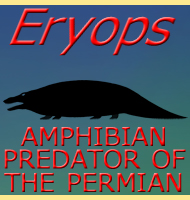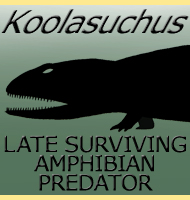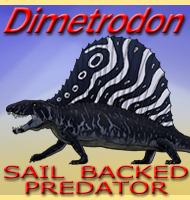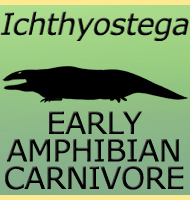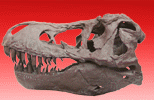


Prionosuchus
Name:
Prionosuchus.
Phonetic: Pre-on-o-soo-kus.
Named By: L. I. Price - 1948.
Classification: Chordata, Amphibia,
Temnospondyli, Archegosauridae, Platyoposaurinae.
Species: P. plummeri (type).
Diet: Carnivore/Piscivore.
Size: Most specimens estimated to be about 2-2.5
meters long. One excpetionally large skull however has a length of
about 1.6 meters, suggesting that this individual had a total
body length of at least 5.5 meters long, possibly more.
Known locations: Brazil - Pedra do Fogo
Formation.
Time period: Mid Permian.
Fossil representation: Several individuals,
usually of skulls.
Prionosuchus
was a temnospondyl amphibian that lived in South America during the
Permian, and one that was surprisingly crocodile-like in appearance
with a snout similar to that of a gharial crocodile. Most specimens
of Prionosuchus are fairly small at only about two
and a half meters in
length, but one exceptionally large skull just over one and a half
meters in length has yielded a truly terrifying proposition. With a
skull this large the total body length achievable for Prionosuchus
would have been up to nine meters long, something that not only makes
Prionosuchus possibly the largest temnospondyl
amphibian known, but
also one of the biggest predators of the Permian.
Most
temnospondyl amphibians are perceived to be hunters of aquatic
organisms such as fish and other amphibians, and there certainly is
no evidence to refute this for Prionosuchus.
With the additional
possibility of individuals growing to exceptional sizes, then
Prionosuchus may well be one of the key apex
predators of the Permian.
This would mean that larger Prionosuchus would be
able to attack and
kill almost anything else in the water, even smaller members of their
own species. It is also not impossible that they may have attacked
land dwelling animals that came to the water to drink in a similar
manner as modern day crocodiles, though it should be pointed out that
there is no evidence for this.
A
1991 paper by C. B. Cox and P. Hutchinson
came to the
conclusion that Prionosuchus should be synonymised
with the genus
Platyoposaurus.
A result of this study was that the Pedra do Fogo
Formation in Brazil where Prionosuchus has been
found was credited with
being Mid-Late Permian in age. However, later study of the Pedra do
Fogo Formation has confirmed that it is actually Middle Permian, and
not of the same time as the deposits where Platyoposaurus
has been
found. Although the suggestion could be made that Platyoposaurus
had
an exceptionally long temporal range in the fossil record and that
Prionosuchus should still be included with it,
there is no supporting
evidence for this. As a result, most researchers today prefer to
keep Prionosuchus separate from Platyoposaurus,
especially when the
geographic gap between them is also considered.
Further reading
- Um anfibio Labirinthodonte da formacao Pedra de Fogo, Estado do
Maranhao - Ministerio da Agricultura, Departamento Nacional da
Producao ineral Divisao de Geologia e Mineralogia, Boletim n. 124,
p. 7-32. - L. I. Price - 1948.
- Fishes and amphibians from the Late Permian Pedra de Fogo Formation
of Northern Brazil. - Palaeontology, 34(3): 561-573. -
C. B. Cox & P. Hutchinson - 1991.
- Biological Scaling Problems and Solutions in Amphibians. - Cold
Spring Harbor Perspectives in Biology, a019166. - D. L. Levy
& R. Heald - 2015.
----------------------------------------------------------------------------
Random favourites
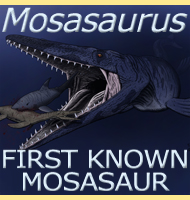 |
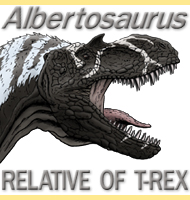 |
 |
 |
